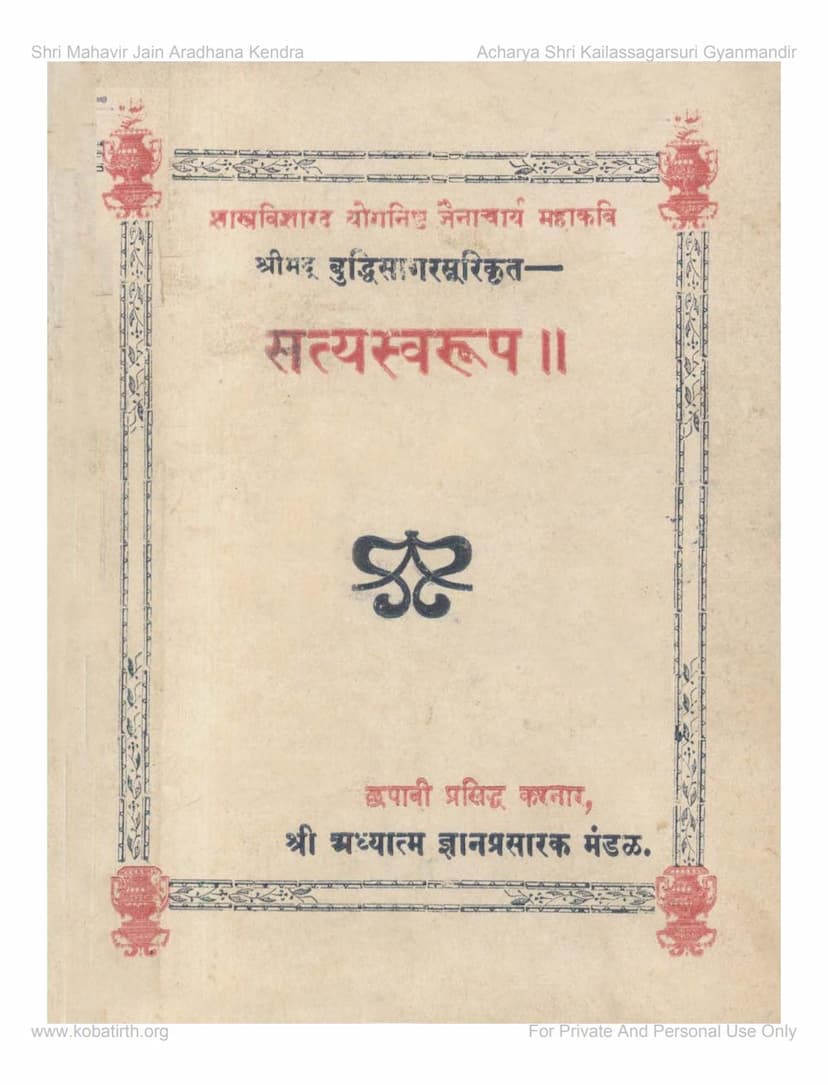Satya Swaroop
Added to library: September 2, 2025

Summary
The book "Satya Swaroop" (The True Form) by Acharya Buddhisagar, published by Adhyatma Gyan Prasarak Mandal, is a comprehensive text that explores various aspects of Jain philosophy and practice. While the provided text is in Gujarati, the summary below focuses on the key themes and discussions presented in the pages.
Overall Theme:
The book emphasizes the importance of Satya (truth) as the ultimate reality and the path to spiritual liberation. It delves into the practical and philosophical aspects of Jainism, aiming to guide readers towards self-realization and righteous living.
Key Content Areas and Discussions:
- The True Nature of Reality (Satya Swaroop): The book begins by establishing the fundamental Jain concept of truth as the ultimate, unchanging essence. It likely contrasts this with the transient nature of the material world.
- The Path to Truth: Acharya Buddhisagar expounds on the Jain path to liberation, which involves rigorous adherence to principles like Ahimsa (non-violence), Satya (truthfulness), Asteya (non-stealing), Brahmacharya (chastity/celibacy), and Aparigraha (non-possession).
- The Importance of the Guru and Righteous Conduct: The text highlights the indispensable role of a spiritual guide (Guru) in understanding the true path. It also stresses the significance of righteous conduct, ethical behavior, and the cultivation of virtues.
- Critique of False Practices and Beliefs: The book likely addresses and debunks various misconceptions, superstitions, and practices that deviate from the core principles of Jainism. It aims to purify the understanding of religious and spiritual pursuits.
- The Human Body and Soul: A significant portion of the text is dedicated to the distinction between the physical body and the eternal soul (Atma). It emphasizes that true happiness and liberation come from realizing the soul's true nature, not from attachments to the perishable body or worldly possessions.
- Karma and Rebirth: The book explains the Jain doctrine of karma, detailing how actions (karma) influence one's present and future lives. It underscores the cycle of birth, death, and rebirth and the means to break free from it.
- The Significance of Jain Practices: Various Jain practices, such as Vrata (vows), Upavasa (fasting), Dhyana (meditation), and Tapa (austerities), are likely discussed in terms of their spiritual efficacy and how they contribute to purification and liberation.
- Social and Ethical Teachings: The text extends its teachings to social conduct, advocating for compassion, charity, respect for all living beings, and the abandonment of vices like alcohol, meat consumption, and unethical behavior. It promotes a virtuous and disciplined lifestyle.
- The Role of the Adhyatma Gyan Prasarak Mandal: The publisher's dedication to disseminating spiritual knowledge is evident. The book serves as a testament to their efforts in making profound Jain teachings accessible.
- Dedication to Shri Mohanlal Himchand Padra: The book is dedicated to Shri Mohanlal Himchand of Padra, highlighting his virtuous life and contribution to Jainism, underscoring the importance of exemplary individuals in spiritual movements.
- Inspirational and Devotional Elements: The presence of devotional verses (stanzas) dedicated to deities and spiritual masters suggests an aim to inspire faith and devotion in the readers.
- The Importance of Self-Reflection and Effort: The book encourages readers to engage in self-reflection, understand their own shortcomings, and make sustained efforts to purify their thoughts, words, and actions.
In essence, "Satya Swaroop" is a profound spiritual treatise that aims to illuminate the path to truth and liberation through the teachings of Jainism. It combines philosophical depth with practical guidance, encouraging readers to live a life of virtue, compassion, and self-awareness.